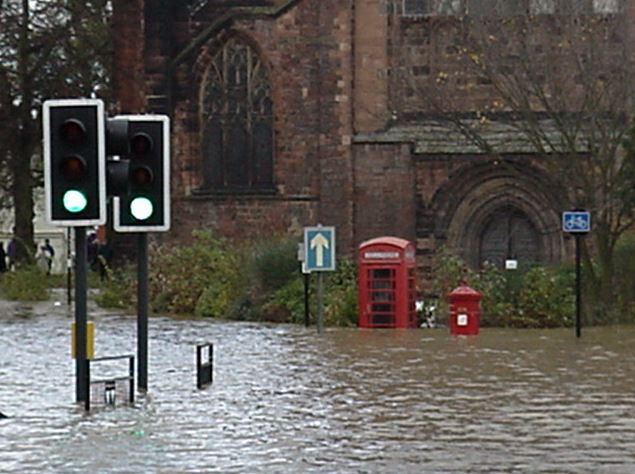If you plant trees strategically on floodplains, you are more likely to stop flooding, are at least significantly reduce the risk of severe floods, say researchers from the Universities of Southampton and Birmingham in England.
Study supervisor, Professor David Sear from the University of Southampton, and colleagues explained in the journal Earth Surfaces Processes and Landforms (citation below) that the height of flooding in towns downstream could be reduced by up to twenty percent if trees are strategically planted.
The researchers studied a whole river catchment in the New Forest over an area of 100 square kilometres (38.6 square miles) upstream of the town of Brockenhurst in Hampshire.
 Planting trees strategically reduces the risk of severe flooding, scientists found. (Image: BIFoR)
Planting trees strategically reduces the risk of severe flooding, scientists found. (Image: BIFoR)
Does tree planting affect peak height?
Their aim was to understand how river restoration, tree planting and ‘log jams’ might affect the ‘peak height’ of a flood downstream from a built-up area (urban location).
The New Forest is an area in southern England which includes one of the country’s largest remaining tracts of unenclosed pasture land, forest and heathland in the densely-populated south-east of England.
The scientists used a digital terrain model of the landscape and a hydrological model simulation, and found that planting trees along the floodplain and raising the number of logjams, across ten to fifteen percent of the total river length, could reduce the peak height of a potential flood in the town by 6% – when the trees were 25 years old.
Prof. Sear and team found that more extensive river restoration (20% to 25% of the total river length) and floodplain forest resulted in up to a 20% reduction in flood peak height.
 With the incidence of severe weather events increasing in the UK, the Environment Agency is looking for more information on how to reduce the risk of flooding. (Image: Wikipedia)
With the incidence of severe weather events increasing in the UK, the Environment Agency is looking for more information on how to reduce the risk of flooding. (Image: Wikipedia)
As the trees grow and the forests become more mature and complex, i.e. up to 100 years after planting them, reductions in flood peak height are even greater than 20%.
The research was supported by the Environment Agency, which wants more information on the potential of river restoration techniques to be incorporated into wider flood risk management projects.
Natural processes help reduce flood risk
David Sear, a Professor in Physical Geography within Geography and Environment at the University of Southampton, said:
“With increasing interest in alternatives to conventional hard flood defences, there is an urgent need for evidence that these alternatives can work.”
“This research reminds us that natural processes, when targeted carefully, can reduce downstream flood risk alongside other societal benefits including biodiversity and recreation.”
Lead author, Dr. Simon Dixon, a Postdoctoral Research Fellow at the University of Birmingham’s School of Geography, Earth and Environmental Sciences and the Institute of Forest Research (BIFoR), said:
“As our research shows, targeted tree planting and restoration can contribute to reducing flood risk. We believe that tree planting can make a big contribution to reducing flood risk, and should be part of a wider flood risk management approach, including conventional flood defences.”
“Tree planting would represent an extra element that helps to slow down the arrival of rain water to vulnerable locations.”
Log jams maybe not so good?
The scientists also gathered and analyzed data on engineered log jams – man-made dams which have several ecological benefits and have been shown to locally decelerate the flow of rivers.
Experts had thought that log jams were a positive intervention and could form part of an overall strategy for reducing flood risk.
However, in this study, the researchers found that although logjams slow down river-flow locally, this sometimes did not translate to reduce flood risk at the catchment scale.
While logjams reduce downstream flood risk in some locations, in others the effect was found to be zero, or even detrimental (higher flood risk).
The scientists say further studies are needed to identify the best locations to install them for flood mitigation.
Dr. Dixon added:
“Logjams contribute to slowing the flow by backing up water and pushing it onto the floodplain. In locations where the floodplains are meadows or crops the water may still be able to flow over the surface quickly.”
“To make the best contribution to flood mitigation it is important they are used in locations with complex bankside vegetation to slow water flowing over the floodplain.”
In an Abstract in the journal, the authors wrote:
“The most promising restoration scenarios for flood risk management are for riparian forest restoration at the sub-catchment scale, representing 20-40% of the total catchment area, where reductions in peak magnitude of up to 19% are observed through de-synchronisation of the timings of sub-catchment flood waves.”
“Sub-catchment floodplain forest restoration over 10-15% of total catchment area can lead to reductions in peak magnitude of 6% at 25 years post-restoration.”
The research formed part of an Environment Agency PhD studentship held by Dr. Dixon, and supervised by Prof. Sear at Southampton University.
Citation: “The effects of river restoration on catchment scale flood risk and flood hydrology,” S.J. Dixon, D.A. Sear, N.A. Odoni, T. Sykes and S.N. Lane. Earth Surface Processes and Landforms. March 2016. DOI: 10.1002/esp.3919.
Video – Cumbria sees record rainfall in 24 hours
In December 2015, large areas of north-west England were under water after nearly 14 inches of rain fell in just 24 hours in parts of the country, leaving hundreds of homes flooded and several tens of thousands of families with no electricity.
